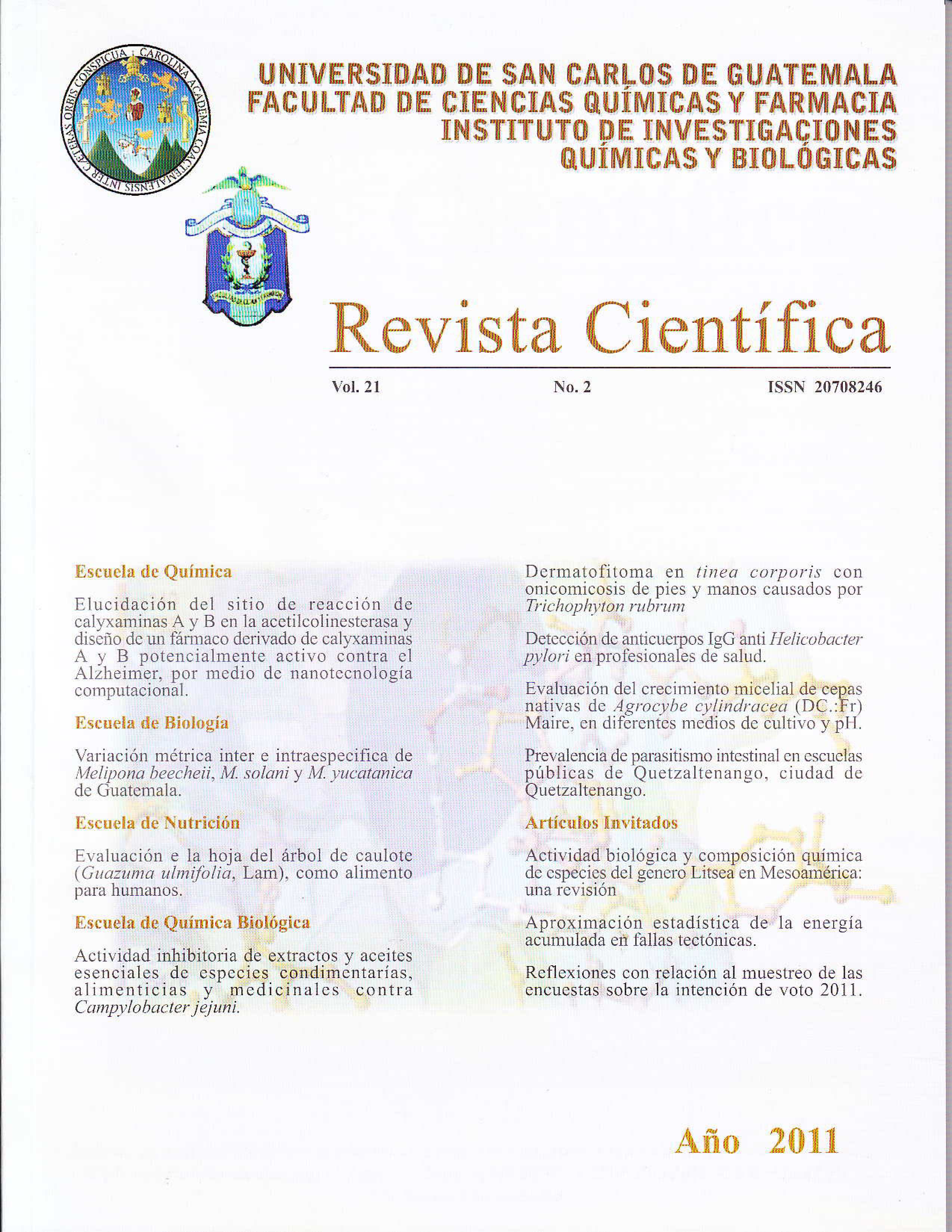Evaluation of Caulote tree leafs (Guazuma ulmifolia Lam) as human's nutrient.
DOI:
https://doi.org/10.54495/Rev.Cientifica.v21i2.129Keywords:
Caulote, acute toxicity tests, acceptability , proximal chemical analysis, sensory descriptionAbstract
In order to determine the nutritional composition of caulote leaf (Guazuma ulmifolia Lam), its toxicity for humans, acceptability and preference of two preparations produced from them, caulote leaves were collected in Atescatempa, Jutiapa, dehydrated and grounded at laboratory. Applying Weende system for proximal chemical analysis, it was determined that the caulote leaves (G. ulmifolia Lam) has a high moisture content, fiber and protein, although less protein than other leaves used in human food. The mineral profile indicates it has a high content of calcium, iron and magnesium. Calcium and magnesium is twice that other leaves as macuy, bledo and amaranth leaves. The toxicity study indicates that caulote leaves (G. ulmifolia Lam) is not toxic for human consumption. The sensory description indicates that caulote leaves has a rough and ropy texture, resulting in a scraping sensation on the tongue. The acceptability of tamalito with caulote leaves and caulote leaves soup, evaluated on a scale of 1 to 5 (1 lowest and 5 highest acceptance), resulted in 4.31 and 2.96 respectively, being this difference significant. The preference was higher for tamalito than soup.
Downloads
References
Arencibia, D.F. et al (2003). Algunas consideraciones sobre la determinación de la toxicidad aguda. Revista Toxicología en línea. Recuperado de http://www.sertox.com.ar/img/item_full/22001.pdf
Charley. H (1987). Tecnología de Alimentos. Procesos químicos y físicos en la preparación de alimentos, Editorial Limusa Noriega. México, 757 p
Francis, J.K, (1995). Guazuma ulmifolia Lam. Guácima Sterculiaceae Familia del cacao, (en línea). Recuperado de http://www.fs.fed.us/global/iitf/Guazumatilmifolia.pdf
Greenfield. H. y Southgate. D.A.T. (Fdl. (2003). Datos de composición de alimentos. Obtención, gestión y utilización (2a cd. i. Roma: Organización de las Naciones Unidas para la Agricultura y la Alimentación.
Jackson. M.L. (1970). Análisis Químicos de Sucios (2da cd.) Barcelona. España. Omega.
Kirchgcssner, M. (1987). Ticremahrung. Alemania, Technischen Universitár München. Instituí fúr Emahrungsphysilogie. p. 21 -24.
INCAP-OPS (2006). Tabla de composición de alimentos de Centroamcrica. Recuperado de http://www.tabladealimentos.net/tea/TablaAlimentos/inicio.html
Ministerio de Educación. Secretaría de Seguridad Alimentaria y Nutricional. ( 2009). Tercer Censo Nacional de Talla en escolares del primer grado de educación primaria del sector oficial de la República de Guatemala. Guatemala 4 al 8 de agosto de 2008. 97p
Ministerio de Salud Pública y Asistencia Social, el al (2009). V Encuesta Nacional de Salud Materno Infantil 2008-2009. Pp 44-46. Recuperado de: http://www.ine.gob.gt/np/ensmi/Informe_ENSMI2008_2009 pdf
Watts, B. et al. (1992). Métodos sensoriales para la evaluación de alimentos. Otawa Centro Internacional de Investigación para el Desarrollo. 170 p.
Downloads
Published
How to Cite
Issue
Section
License
Copyright (c) 2011 H.R. Pérez, J. Salazar

This work is licensed under a Creative Commons Attribution 4.0 International License.
Authors who publish with this journal agree to the following terms:
- Authors retain copyright and grant the journal right of first publication with the work simultaneously licensed under a Creative Commons Attribution License 4.0 that allows others to share the work with an acknowledgement of the work's authorship and initial publication in this journal.
- Authors are able to enter into separate, additional contractual arrangements for the non-exclusive distribution of the journal's published version of the work (e.g., post it to an institutional repository or publish it in a book), with an acknowledgement of its initial publication in this journal.
- Authors are permitted and encouraged to post their work online (e.g., in institutional repositories or on their website) prior to and during the submission process, as it can lead to productive exchanges, as well as earlier and greater citation of published work.









